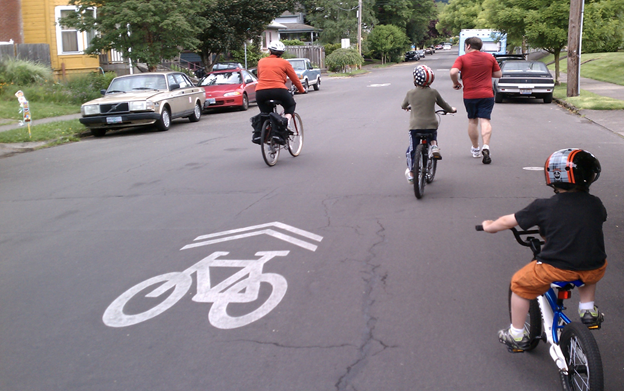Safety over speed: Safe streets are climate-friendly streets
Lowering speeds have more benefits besides saving lives: street designs that keep speeds low help reduce carbon emissions, too. In this blog post by our friends at the Natural Resources Defense Council (NRDC), Ann Shikany and Carter Rubin discuss how safer roads increase rates of biking, walking, and transit ridership, and enable fewer and shorter car trips.

Slow neighborhood greenways help people get around without getting in their cars. Photo via City of Seattle.
In communities across the county, our transportation system provides key linkages for commuters to jobs, kids to school and all of us to our social, family and recreational opportunities.
But the flip-side is that after decades of prioritizing transportation investments in new highways with a focus on speed above all else, we’re stuck with a transportation system that produces more carbon emissions than any other sector in the United States. Spread-out development facilitated by wide fast roads make cars all but essential for daily travel in many U.S. communities.
When you dive deeper into those carbon emissions—you’ll find that 59 percent of them come from light-duty vehicles—that includes the cars we drive around in for most daily trips. While the majority of daily trips are less than three miles, most of them are made by car.
Even worse, transportation emissions are rising because people are driving more and making longer trips. Even with cleaner fuels (not to mention electric cars) and more efficient vehicles, the uptick in driving more is obliterating any emissions benefits.
Why are people driving more, and using cars for even short trips? Because, with an overarching focus on vehicle speed and avoiding delay, nearly everything we’ve built for 60 years has been designed for high speed vehicle movement, which makes getting around by any other mode—biking, public transportation, or your own two feet—dangerous and unpleasant. Our transportation system—and the federal policy that built it—forces many Americans to drive to get just about anywhere.
The good news is over 40 cities in the United States have adopted Vision Zero policies that seek to eliminate traffic fatalities and major injuries on our roads through safety policies and investment in the kind of infrastructure that will help keep everyone safe—with a priority on those who are most vulnerable.
Some of the key strategies that cities use to meet this goal include:
- Providing physical protection for people walking and biking, like bike lanes protected with planters, bollards and curbs.
- Reducing vehicle speeds on routes intended for people walking and biking, so that people of all ages and abilities feel safe.
Projects that lower speeds and make it easier to bike, walk, and use transit also compliment land use changes that bring destinations closer together. Slower speeds allow our streets to become places where people want to be, not race through. (As our own Carter Rubin said sarcastically when asked about the economic benefits of lower speeds during yesterday’s #SafetyOverSpeed tweet chat: “Brb, going to go shopping on the side of a freeway.” )
Improving bike and pedestrian networks is also one of the top policy priorities included in the Bloomberg American Cities Climate Challenge, and is being supported in nine challenge cities. If you’d like more detailed information on these policies, check out the Climate Action Playbook sections on bike and pedestrian infrastructure. We’ll also give you a quick snapshot of what this policy looks like in action:
Prioritizing bikeway, sidewalk and crossing improvements (Portland, OR): Portland leads large U.S. cities in the percentage of commuters who bike to work and ranked tenth in 2016 for the percentage of commuters who walk to work. The city has 350 miles of bikeways, with more than 50 miles funded to be installed in the next few years. Portland has developed this infrastructure not just by creating bike plans, but by backing these plans up with funding. Portland is currently updating its pedestrian plan to prioritize sidewalk and crossing improvements and other investments to make walking safer and more comfortable across the city. It will identify gaps and needs in Portland’s pedestrian network, prioritize funding to locations with the greatest need first, and identify performance measures to track progress. (Read more.)
Responding to the need for safety improvements (Cincinnati, OH): After facing a record breaking year of pedestrian-involved crashes—430 in 2018—Cincinnati Councilmember Greg Landsman led the charge for safer streets. The city is now pursuing a Vision Zero strategy that included appointing new leadership and dedicated staff resources within the city’s Department of Transportation, prioritized funding for pedestrian safety improvements, and increased enforcement. Through the American Cities Climate Challenge, Cincinnati’s transportation team will also receive Vision Zero design training from the National Association of City Transportation Officials (NACTO). (Read more.)
Every community deserves safe streets, clean air and action on climate. Thankfully, many cities are taking the first step by implementing Vision Zero policies locally. There is also work to be done at the federal level. On October 23, 2019, Representative Earl Blumenauer introduced the Vision Zero Act, which would make Vision Zero policies and investments eligible for federal funding. NRDC supports this legislation. Transportation for America’s push for safer streets as part of a comprehensive federal transportation investment strategy.



















